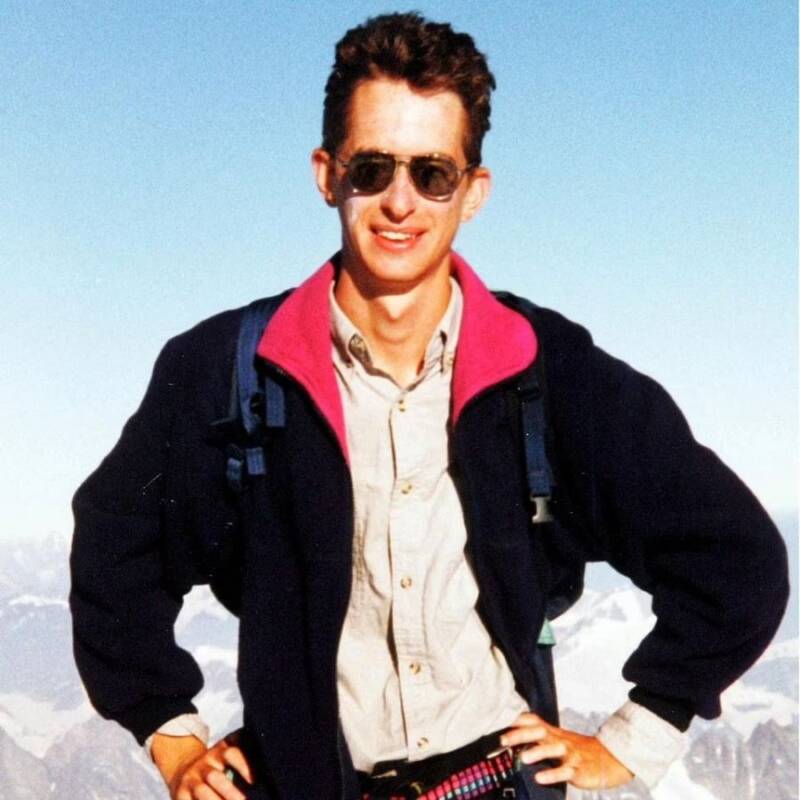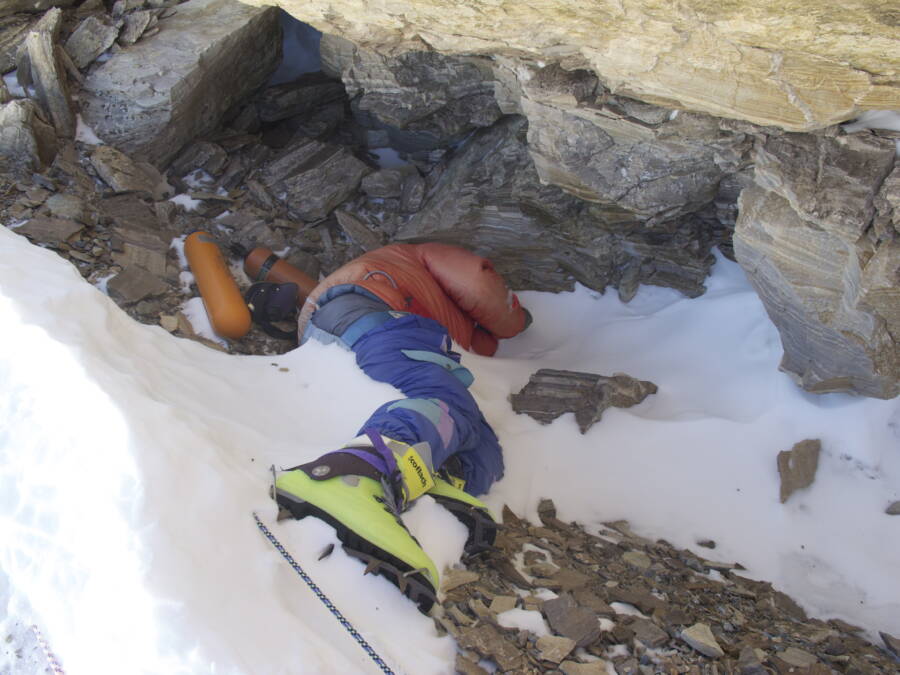On May 15, 2006, David Sharp died on the Northeast Ridge of Mount Everest after becoming immobile due to frostbite and a lack of oxygen. The 40 climbers who passed him as he struggled later faced harsh criticism for not trying harder to save him.

Sharp Family/North News and PicturesDavid Sharp was just 34 years old when he perished on Mount Everest.
Before David Sharp left England for his quest to conquer Mount Everest, he reassured his worried mother that on the mountain, “you are never on your own. There are climbers everywhere.”
In May 2006, Sharp made his third attempt to summit Everest. He’d tried to climb the mountain twice before but was forced to turn back before he reached the top due to frostbite. This time, he was determined to make it — and he wanted to do it on his own. He decided not to use a Sherpa, and he even took less supplemental oxygen than recommended.
On the evening of May 14, he tried to reach the peak. Nobody knows if he succeeded. In the early morning hours of May 15, he was spotted huddled in a crevice near the top of the mountain. His limbs were already freezing, and he couldn’t move. Around 40 climbers passed by him that day, but he was in the “Death Zone” at an elevation of 28,000 feet, and there was nothing they could do to help him. David Sharp died on Mount Everest at age 34.
In the aftermath, those who passed Sharp faced harsh criticism, and his death sparked debate about a climber’s duty to help others. However, even Sharp’s own mother insisted that nobody should have to risk their own life to save someone else.
David Sharp’s Attempts To Climb Mount Everest
David Sharp was an English engineer and an experienced mountaineer who first tried to scale the world’s highest mountain in 2003. That year, he’d had to turn around after suffering from severe frostbite that ultimately cost him part of two toes. Then, in 2004, he tried again to summit Everest, but he turned back once more due to exhaustion and frigid temperatures.

Public DomainMore than 340 people have died while climbing Mount Everest.
Still, that didn’t deter Sharp. As reported by USA Today in 2006, he even once told a fellow camper, “I would give up more toes — or even fingers — to get on top.”
So, in 2006, David Sharp decided to make a third attempt — and he wanted to do it alone. He didn’t hire a Sherpa, and he made the controversial choice to only take a small amount of supplemental oxygen. He felt that reaching the peak without using oxygen would be an even bigger accomplishment, and another climber had suggested that lugging the heavy canisters up the mountain would only tire him out.
These decisions cost him his life.
The Discovery Of The Frozen Mountaineer
David Sharp began his fateful push to the top of Everest on the evening of May 14, 2006. Around 1 a.m. on May 15, a group of climbers spotted him sitting in a cave next to the infamous body of “Green Boots,” a climber who died on the mountain in 1996 and whose frozen corpse now serves as a macabre landmark.
It seemed that Sharp had stopped to rest in the cave on his way back down Everest — but because his camera was missing, nobody knows if he ever reached the peak. Sharp wasn’t wearing an oxygen mask, his eyelashes were covered in ice, and he wasn’t moving. “The poor guy’s stuffed,” said one of the passing climbers. Because they thought he was already in a coma, they didn’t radio for help.

Maxwelljo40/Wikimedia CommonsDavid Sharp died not far from “Green Boots,” a man who perished on Everest in 1996.
Around 20 minutes later, another group came upon Sharp in the cave. They shouted at him to get up and move on, but this time, Sharp seemingly waved them off, not saying a word. Dozens of other climbers passed by Sharp that morning, some of whom attempted to speak to him and whose varying accounts of his condition would spark the controversy that followed his death.
One man, Maxime Chaya, radioed for help when he noticed that Sharp was still alive despite the fact that his fingers were frozen solid and his nose was solid black from frostbite. He tried to give Sharp oxygen, but his partner told him, “There’s nothing you can do.” Chaya wept, recited the Lord’s Prayer, and continued his descent before he ran out of oxygen himself.
Two hours later, another group tried to help, too. Two Sherpas spent 20 minutes attempting to get Sharp to his feet, but their efforts were in vain. After moving him into the sunlight, they had no choice but to leave him.

National Geographic/YouTubeA camera crew following climber Mark Inglis unintentionally captured some of David Sharp’s final moments.
David Sharp died on the side of Mount Everest that day, his frozen arms clasping his legs. But that wasn’t the end of his story.
The Controversy Surrounding David Sharp’s Death
David Sharp’s death sparked a series of heated debates, mainly because of the sheer number of people who had passed by him while he was still alive. However, it’s unclear if he could have been saved at all.
Sharp was at an altitude of just below 28,000 feet, well into Everest’s “Death Zone.” Some of the climbers who saw him were fighting for their lives themselves with low levels of oxygen in their tanks and the early stages of frostbite and hypothermia threatening to leave them incapacitated, too.
One of the men who passed Sharp was Mark Inglis, who was attempting to become the first double amputee to reach the summit of Everest. He was in no condition to assist Sharp, and he even had to be carried down part of the mountain on a Sherpa’s back. Despite this, Inglis faced harsh criticism in the aftermath of Sharp’s death for not doing more to help him.

Jamie McGuinness/WikiA memorial for David Sharp on Mount Everest.
Sir Edmund Hillary, the first climber to reach Everest’s summit alongside his guide, Tenzing Norgay, was particularly disgusted by the attitudes of the climbers who hadn’t aided Sharp. Hillary decried the fanaticism of “people [who] just want to get to the top” and told the New Zealand Herald that “on my expedition, there was no way that you would have left a man under a rock to die.”
The situation may have ended differently if David Sharp had still been mobile when others found him. There have been cases of people stuck on Everest being successfully rescued because, while weak, they were still able to move with some help. Sadly, that wasn’t the case for Sharp.
Even Sharp’s mother, Linda, had no hard feelings toward the climbers who passed her son. As The New York Times reported at the time, Linda said, “Your responsibility is to save yourself — not to try to save anybody else.”
David Sharp remains on Mount Everest today. His body was moved from the main path and is no longer visible, but his story lingers, a quiet reminder of the perils of the mountain.
After learning about David Sharp and his death on Mount Everest, go inside the story of Marco Siffredi, the man who died while snowboarding down Everest. Then, read about Beck Weathers, whose escape from certain death on Mount Everest was nothing short of a miracle.





